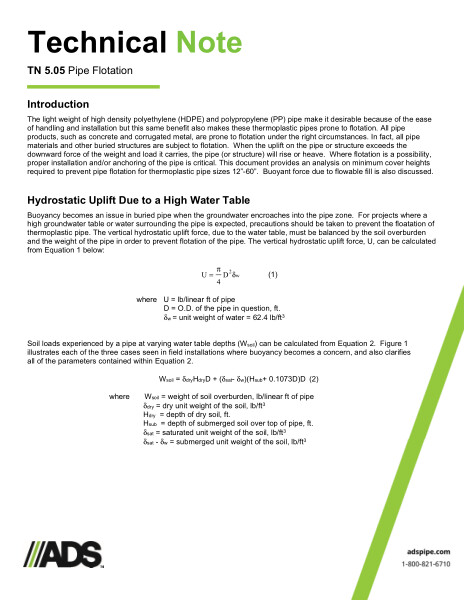TN 5.05 Pipe Flotation
Filename:
TN 5.05 Pipe Flotation.pdf

This document is the TN 5.05 Pipe Flotation. Hydrostatic uplift due to a high water table explained with equations, diagrams and tables.
The light weight of high density polyethylene (HDPE) and polypropylene (PP) pipe make it desirable because of the ease of handling and installation but this same benefit also makes these thermoplastic pipes prone to flotation. All pipe products, such as concrete and corrugated metal, are prone to flotation under the right circumstances. In fact, all pipe materials and other buried structures are subject to flotation.
When the uplift on the pipe or structure exceeds the downward force of the weight and load it carries, the pipe (or structure) will rise or heave. Where flotation is a possibility, proper installation and/or anchoring of the pipe is critical.
This document provides an analysis on minimum cover heights required to prevent pipe flotation for thermoplastic pipe sizes 12”-60”. Buoyant force due to flowable fill is also discussed.
Hydrostatic Uplift Due to a High Water Table shows how buoyancy becomes an issue in buried pipe when the groundwater encroaches into the pipe zone. For projects where a high groundwater table or water surrounding the pipe is expected, precautions should be taken to prevent the floatation of thermoplastic pipe. The vertical hydrostatic uplift force, due to the water table, must be balanced by the soil overburden and the weight of the pipe in order to prevent flotation of the pipe. A vertical hydrostatic uplift force and soil loads equations provided.
Figure 1 shows the installation conditions for possible flotation of thermoplastic pipe. Table 1 has the values for approximate weights of ADS thermoplastic pipe. A minimum cover equation, a forces affecting flotation diagram, a table for minimum recommendation cover to prevent flotation of ADS thermoplastic pipe and calculation of minimum depth are included.
For anchoring systems, pipe flotation may simply be addressed with adequate cover. In those situations where adequate cover cannot be achieved, there are a number of acceptable alternate methods for restraining the pipe. Pipe stabilization alternatives are provided. Uplift due to flowable fill backfill is explained.
